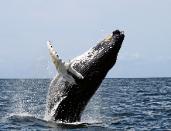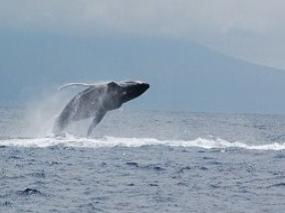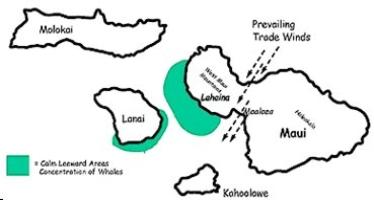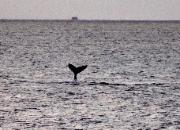
HALE ONO LOA #301 (707) 322-0945
Humpback Whales of Maui (Megaptera Novaeangliae)
Humpback Whales are protected in Hawaii by the Marine Mammal Protection Act and the Endangered Species Act. The whale population is
increasing at about 7% per year thanks to protective measures, however they have not yet recovered to their original population levels and
remain an endangered species. Federal protects humpbacks from being harmed or harassed. Approaching by means of Kayaks to ferries
within 100 yards (300 feet) is prohibited. IF YOU SEE WHALES BEING HARASSED OR BEING APPROACHED WITHIN THE 100
YARD RANGE, CALL 888 256-9840 (NOAA Fisheries Enforcement)
Why Maui?
North Pacific Humpback Whales seem to choose the Maui area for a number of reasons:
1. Water Temperature
The new calves are born without a protective blubber layer so they need the warm water to survive. Since Hawaiian water temperatures average around
75 degrees. This creates a more suitable environment for the newborn calves.
2. Topography
Maui's unique topography is another reason why the Humpback whales spend their winters here, the islands shelter and protect the waters. As the islands
are in such close proximity, they form a shallow basin at the bottom as compared to the deep surrounding Pacific Ocean waters at 1 to 3 miles depths. The
average depth in the area off Lahaina is only about 300 feet. For humans, 300 feet is considered well beyond our safe diving range, but for a 45 foot
Humpback whale, 300 feet is just right. Humpbacks seem to prefer "shallow/protected" waters and spend the majority of their lives in waters that are 300
feet or less.
3. Lack of Predators
Another reason to come to Maui is that Hawaiian waters are virtually predator free for the Humpback whales. Humpback whales have very few natural
predators. There are a few species of sharks that will feed on the sick, the injured, and the young. Their only other predators, besides humans, are Orcas,
the killer whale. In Hawaii, we rarely see Orcas as they prefer colder waters. The humpbacks encounter Orcas on a regular basis in Alaska, and as such,
around 20% of Humpback whales bear scars from Orca attacks.
FAQs
Where is the best place and time to see the whales?
This is always a hit and miss proposition. The first whales begin to arrive as early as the end of November and stay until as late as May. The best viewing time is mid-
December to mid-March. The whales can be sighted from any vantage point where you can see the water. The higher up and the closer you are, the better chances you
have. The whale watch cruise operators stay in touch with each other via radio relating where the whales have been spotted, patience has its rewards, so keep a watchful eye
for that “water vapor” rising up from the water. That is a whale's “blow”'.
How large are the whales and what do they weigh?
Humpback Whales weigh approximately 1 ton (2000 pounds) for every foot of length. Adult males reach a length of 40 feet and weigh in at 40 tons.
How do researchers identify one whale from another?
Humpback Whales can be identified by the markings and shape of their tails. These indentifying markings are as individual as our fingerprints. Researchers take pictures of all
whales sighted and catalog the pictures in large albums. Each year they compare the new pictures to the ones previously catalog. They then can tell which whales are
returning to Maui each year. One year they had sighted a specific whale in Baja California and then three weeks later the same whale was sighted in the waters around Maui. It
was something that they had not expected.
What is "Tail Slapping"?
This is when a whale will hit the surface of the water with its tail in a slapping motion. It is not quite known why they do this. Researchers have speculated that it is used by
the males to either attract females or it is an aggressive posture to ward off other males.
What is "Breaching"?
This is when the whale lifts almost its entire body out of the water. It will turn its body while in the air so that it will land on its back. Researchers speculate that they breach
to remove parasites such as barnacles from their bodies. Other theories are that they want to take a look around, they are just being playful, or that they are trying to attract
the attention of other whales.
What is "Fluke Slapping"?
This is when the whale will raise one of its two flukes and slap it against the surface of the water. Researchers believe this is another aggressive posture toward other whales.
It is also believed to be a method that the female whale uses to stress or enforce a lesson to her calf.
What is "Spy Hopping"?
This is when the whale will poke its head out of the water vertically just far enough for his eyes to break the surface. Researchers believe they do this to look around to either
see who or what is around or to get their bearings.
How many whales visit the Maui waters?
Approximately 1,500 to 2,000 humpback whales visit the waters around Maui each year.
What do the whales eat while they are in Maui?
The whales do not eat while they are here. They live off their thick coat of blubber. They only feed in the polar waters near Alaska during the summer and fall months. They
are baleen whales. They feed only on small shrimp-like critters called krill which are abundant in the polar waters.
How do they eat?
The humpback will dive down deep under a large swarm of krill. It will begin a slow circular motion while blowing bubbles out of its blowhole. The rising bubbles corral the
krill. The whale will then open its mouth fully and swim up through the center of the circle of bubbles it created scooping up the corraled krill. It will continue its upward
movement until it breaks the surface of the water. The water will then flow out through the baleen but leaving the krill trapped in the whale’s mouth. The whale ends up with
a feast.
How much weight do the calves gain each day?
The female will nurse her calve to gain 200 pounds a day during the first few weeks of life.
How close can I get to the whales?
In 1992 the official Hawaiian Islands Humpback Whale National Marine Sanctuary came into being. Under this Act, it is unlawful for anyone, without special permission, to
come within 300 yards of the humpbacks in the known calving areas and 100 yards in all other areas.
How often do whales breathe?
Humpbacks need to breathe every 7 to 20 minutes.
What kind of binoculars are good for whale watching?
10x40 wide angle lens work very well. High definition is even better.
Which gender of the Humpback Whale does the singing?
The male whale is the only one that sings. The exact function is unknown. Males of the same population sing the same song.
Humpback Whales are protected in Hawaii by the Marine Mammal Protection Act and the Endangered Species Act. The whale population is
increasing at about 7% per year thanks to protective measures, however they have not yet recovered to their original population levels and
remain an endangered species. Federal protects humpbacks from being harmed or harassed. Approaching by means of Kayaks to ferries
within 100 yards (300 feet) is prohibited. IF YOU SEE WHALES BEING HARASSED OR BEING APPROACHED WITHIN THE 100
YARD RANGE, CALL 888 256-9840 (NOAA Fisheries Enforcement)
Why Maui?
North Pacific Humpback Whales seem to choose the Maui area for a number of reasons:
1. Water Temperature
The new calves are born without a protective blubber layer so they need the warm water to survive. Since Hawaiian water temperatures average around
75 degrees. This creates a more suitable environment for the newborn calves.
2. Topography
Maui's unique topography is another reason why the Humpback whales spend their winters here, the islands shelter and protect the waters. As the islands
are in such close proximity, they form a shallow basin at the bottom as compared to the deep surrounding Pacific Ocean waters at 1 to 3 miles depths. The
average depth in the area off Lahaina is only about 300 feet. For humans, 300 feet is considered well beyond our safe diving range, but for a 45 foot
Humpback whale, 300 feet is just right. Humpbacks seem to prefer "shallow/protected" waters and spend the majority of their lives in waters that are 300
feet or less.
3. Lack of Predators
Another reason to come to Maui is that Hawaiian waters are virtually predator free for the Humpback whales. Humpback whales have very few natural
predators. There are a few species of sharks that will feed on the sick, the injured, and the young. Their only other predators, besides humans, are Orcas,
the killer whale. In Hawaii, we rarely see Orcas as they prefer colder waters. The humpbacks encounter Orcas on a regular basis in Alaska, and as such,
around 20% of Humpback whales bear scars from Orca attacks.
FAQs
Where is the best place and time to see the whales?
This is always a hit and miss proposition. The first whales begin to arrive as early as the end of November and stay until as late as May. The best viewing time is mid-
December to mid-March. The whales can be sighted from any vantage point where you can see the water. The higher up and the closer you are, the better chances you
have. The whale watch cruise operators stay in touch with each other via radio relating where the whales have been spotted, patience has its rewards, so keep a watchful eye
for that “water vapor” rising up from the water. That is a whale's “blow”'.
How large are the whales and what do they weigh?
Humpback Whales weigh approximately 1 ton (2000 pounds) for every foot of length. Adult males reach a length of 40 feet and weigh in at 40 tons.
How do researchers identify one whale from another?
Humpback Whales can be identified by the markings and shape of their tails. These indentifying markings are as individual as our fingerprints. Researchers take pictures of all
whales sighted and catalog the pictures in large albums. Each year they compare the new pictures to the ones previously catalog. They then can tell which whales are
returning to Maui each year. One year they had sighted a specific whale in Baja California and then three weeks later the same whale was sighted in the waters around Maui. It
was something that they had not expected.
What is "Tail Slapping"?
This is when a whale will hit the surface of the water with its tail in a slapping motion. It is not quite known why they do this. Researchers have speculated that it is used by
the males to either attract females or it is an aggressive posture to ward off other males.
What is "Breaching"?
This is when the whale lifts almost its entire body out of the water. It will turn its body while in the air so that it will land on its back. Researchers speculate that they breach
to remove parasites such as barnacles from their bodies. Other theories are that they want to take a look around, they are just being playful, or that they are trying to attract
the attention of other whales.
What is "Fluke Slapping"?
This is when the whale will raise one of its two flukes and slap it against the surface of the water. Researchers believe this is another aggressive posture toward other whales.
It is also believed to be a method that the female whale uses to stress or enforce a lesson to her calf.
What is "Spy Hopping"?
This is when the whale will poke its head out of the water vertically just far enough for his eyes to break the surface. Researchers believe they do this to look around to either
see who or what is around or to get their bearings.
How many whales visit the Maui waters?
Approximately 1,500 to 2,000 humpback whales visit the waters around Maui each year.
What do the whales eat while they are in Maui?
The whales do not eat while they are here. They live off their thick coat of blubber. They only feed in the polar waters near Alaska during the summer and fall months. They
are baleen whales. They feed only on small shrimp-like critters called krill which are abundant in the polar waters.
How do they eat?
The humpback will dive down deep under a large swarm of krill. It will begin a slow circular motion while blowing bubbles out of its blowhole. The rising bubbles corral the
krill. The whale will then open its mouth fully and swim up through the center of the circle of bubbles it created scooping up the corraled krill. It will continue its upward
movement until it breaks the surface of the water. The water will then flow out through the baleen but leaving the krill trapped in the whale’s mouth. The whale ends up with
a feast.
How much weight do the calves gain each day?
The female will nurse her calve to gain 200 pounds a day during the first few weeks of life.
How close can I get to the whales?
In 1992 the official Hawaiian Islands Humpback Whale National Marine Sanctuary came into being. Under this Act, it is unlawful for anyone, without special permission, to
come within 300 yards of the humpbacks in the known calving areas and 100 yards in all other areas.
How often do whales breathe?
Humpbacks need to breathe every 7 to 20 minutes.
What kind of binoculars are good for whale watching?
10x40 wide angle lens work very well. High definition is even better.
Which gender of the Humpback Whale does the singing?
The male whale is the only one that sings. The exact function is unknown. Males of the same population sing the same song.



Viewing Spots:
The beaches and ocean front
dining rooms of South and West
Maui are prime spots, and the drive
along Maalaea and West Maui is
peppered with scenic pull-offs.
These are among the best:
Watch for distracted
drivers who may
suddenly stop to view
whales!!
Marine Debris is the
leading killer of whales and
all marine mammals. Nets,
lines, buoys and trash can
tangle or be swallowed.
Pick up beach trash.
Photography Tips:
Whale Behaviors:
The beaches and ocean front
dining rooms of South and West
Maui are prime spots, and the drive
along Maalaea and West Maui is
peppered with scenic pull-offs.
These are among the best:
- Maalaea Harbor
- Papawai Lookout
- Launiupoko Wayside
- Kaanapali Beach
- Puu Kekaa (Black Rock)
- Honolua Bay
Watch for distracted
drivers who may
suddenly stop to view
whales!!
Marine Debris is the
leading killer of whales and
all marine mammals. Nets,
lines, buoys and trash can
tangle or be swallowed.
Pick up beach trash.
Photography Tips:
- Hold camera steady.
- Do not follow the whale
through its movements. - Set shutter speed to 5
hundredth of a second.
Whale Behaviors:
- BLOW: When a whale
exhales at the surface a
bushy cloud of water vapor
is produced. - PEDUNCLE ARCH: As a
whale dives, it may arch its
body high above the water,
so that the caudal peduncle
appears. - FLUKE UP DIVE: Following
a peduncle arch, the
humpback will bring it tail
fluke above the surface of
the water so that the entire
underneath surface fluke is
exposed - PEC SLAP: The whale rolls
sideways at the surface,
slapping a pectoral din
against the water. Some-
times whales lay on their
backs and slap both fins. - BREACH: The whale
propels itself out of the
water, clearing the surface
with 2/3 of its body or more. - SPY HOP: The whale rises
his head straight up out of
the water to just below the
eyes. - HEAD SLAP: Lunging head
first out of the water the
whale pounds its massive
mouth on the surface. - TAIL SLAP: The forceful
slapping of the tail flukes
against the surface of the
water.
